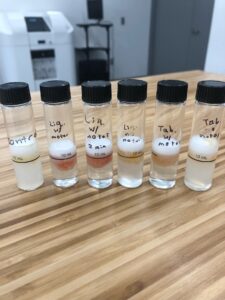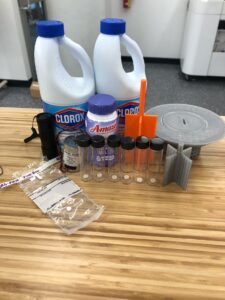The team believed it was best to prototype the way the system would clean the water and kill E. Coli. contaminants. The team did this by looking into codes and standards of how to effectively disinfect the water. The CDC requirement was that water for the wash and pack station must contain zero CFU organismic colonies of E.Coli. Because that is a main priority in the project, it was deemed one of the first action items. After this, the team researched different methods of eliminating E.Coli: boiling hot water, ultraviolet light treatment, and bleach injection. Ultimately, the final selection was to focus on bleach injection due to the other two methods requiring more energy which goes against LaFarm’s efforts to use less energy and transition to renewable energy efforts.
During testing, we looked at using liquid bleach and bleach tablets which we added to one gallon of water. This was done by letting them mix naturally and agitating the water with a motorized fan blade. In order to evaluate these tests, the team collected samples from each test after 10 minutes. The team followed the instructions on the test and came back 48 hours later to check the results.


The results were checked by looking at the color of the solution. Total coliform was detected if the solution turned yellow and the gel rose to the surface which happened with the control sample, the black tablet no motor sample, and the tablet with motor sample. The liquid no motor sample turned yellow but the gel did not rise which meant the ph changed but no e.coli formed in the sample. Total coliform was not detected and there was no ph change in the liquid bleach with motor samples taken after both 3 and 10 minutes because their colors changed to red and the gel stayed at the bottom of the test tube.
The team met with Josh Parr, the main end user of the design, to talk about this prototype but also at the design review where he provided thoughts and feedback. The design review was helpful because the team was able to get the advice from Josh and other senior design students who brought different knowledge and ideas to the team’s attention. From the prototype the team learned that liquid bleach is the most effective way of killing e.coli and the mixture must sit for a period of time before it becomes effective but this time can be shortened by agitating the mixture. The team learned from the design review that it is important to consider the entirety of the project’s scope and not to get bogged down in the small details for too long. From Josh it became apparent that bleach injection into the water before it is used for washing is important but so too is adding bleach as the water enters the wash and pack station in order to kill bacteria on the produce as well as what was in the water. The team is also considering other methods of agitation such as aeration or using a pump to mix the bleach with the water. When the team looks into pumps it is important to consider that they will beed to be able to withstand various weather conditions. Lastly, there are many Lafayette professors with expertise in related areas that the team can better utilize in research and design.